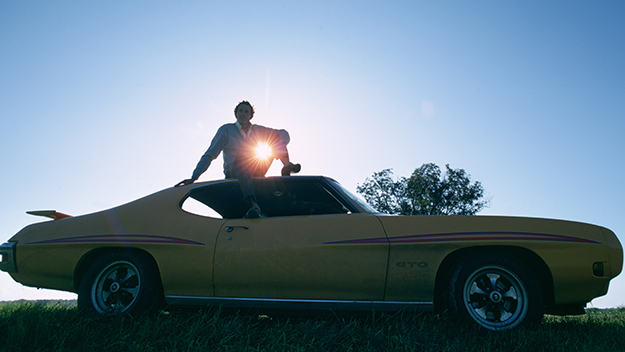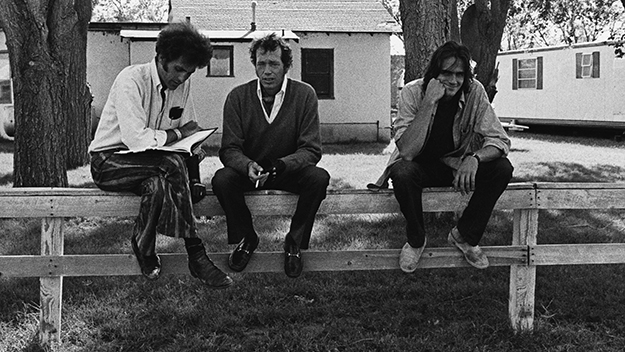Monte Hellman’s Two-Lane Blacktop
An excerpt from this article appeared in the May 6 edition of The Film Comment Letter, our free weekly newsletter featuring original film criticism and writing. Sign up for the Letter here.

Warren Oates in Two-Lane Blacktop (Monte Hellman, 1971). Courtesy the Criterion Collection
“Every word is like an unnecessary stain on silence and nothingness.” — Samuel Beckett, Vogue magazine interview, 1969
Samuel Beckett’s influence is felt so strongly in Monte Hellman’s films that even if one were not aware of Hellman’s oft-professed love of Beckett, it wouldn’t be all that difficult to guess. Beckett’s most famous work is 1953’s Waiting for Godot, a play where two characters sit under a tree and talk. It’s not clear who they are or where they came from. They wait for a character named Godot to arrive. Godot, of course, never shows up. In 1957, Hellman directed a production of Godot at a theatre company he founded in Los Angeles, and he did the play as a western. (The Beckett estate is perhaps the most inflexible literary estate in the world, and would never allow such an interpretation now.) Hellman’s films, particularly the strange, lonely trilogy that makes up his legacy—The Shooting (1966), Ride in the Whirlwind (1966), and Two-Lane Blacktop (1971)—exist in an eerie Beckettian space, where what is absent is more important, and felt more powerfully, than what is present. The characters, moving restlessly through the landscape, have an uneasy awareness that they exist in a meaningless feedback loop, where they are both pursuers and the pursued, and where the final destination is a mirage. In such a world, all human quests take on the aspect of empty ritual. The rest is silence.
It’s not a surprise that such un-ingratiating and, in many ways, pitiless films failed to find American audiences at the time of their release. Hellman got his start (as so many others did) through Roger Corman’s unofficial film school of low-budget thrillers and biker movies. After directing two films starring Jack Nicholson in the Philippines, Hellman got the go-ahead from Corman to shoot two westerns, back-to-back, in the Utah desert. Nicholson appeared in both, as did Millie Perkins. Nicholson wrote the script for Ride in the Whirlwind, and co-produced the film with Hellman. Carole Eastman, who would go on to write Five Easy Pieces (as well as the under-appreciated Puzzle of a Downfall Child), wrote The Shooting, which features many Beckettian lines. Warren Oates’ Willett Gashade, growing increasingly alarmed that their three-person posse is being stalked by an unseen figure: “Somethin’s comin’.” “What are we followin’ anyhow?” “Who’s out there? Who is it?” In the final confrontation, Gashade gets a glimpse of whom he’d been pursuing all this time. It would be facile to say that the moment leaves us with more questions than answers. The whole point is that there is no such thing as an answer in the first place.
Ride in the Whirlwind is almost entirely circular in structure. Three wandering cowhands (Nicholson, Cameron Mitchell, Tom Filer) find themselves caught between warring vigilantes and bandits. The vigilantes assume the cowhands are with the bandits and proceed to hunt them down through the inhospitable moonscape of desert rock. In this environment, it would be impossible for the cowhands to call a time-out and say, “But we aren’t part of that gang at all!” Innocence is irrelevant. “I’m trying to figure out what way to run,” says one of the cowhands. There’s nowhere to go.

Monte Hellman, Warren Oates, and James Taylor on the set of Two-Lane Blacktop (Monte Hellman, 1971)
Two-Lane Blacktop was the only one of these films that generated any “buzz,” and that buzz came before it opened, when Esquire featured the film in their April 1971 issue, declaring it, “Our nomination for the movie of the year.” Maybe people went into it thinking it was going to be Easy Rider, Part Two. Nobody was prepared for an unnerving, melancholy mood-poem. James Taylor and Dennis Wilson, looking for action in their souped-up ’55 Chevy, accept the challenge of a guy driving an off-the-lot GTO (Warren Oates) to race him across the country. A wayward girl (Laurie Bird) comes along for the ride. Two-Lane Blacktop vibrates with the roar of engines, but the silences are an abyss. Everyone’s looking to connect, but the language of connection doesn’t exist. Consider Oates’s performance, a painful and transparent masterpiece, GTO’s loneliness and sense of inferiority covered up with bragging chatter and a wide smile he hopes is convincing. Kent Jones does not overstate things in his Criterion essay on the film when he says: “There’s not another character like Oates’s in all of American cinema.”
Two-Lane Blacktop has so much more to tell us of its own era than any self-consciously serious “message” movie ever could. In Easy Rider, Peter Fonda’s Wyatt says, “We blew it.” His comment has been discussed obsessively ever since. What did he mean? Two-Lane Blacktop knows.
Hellman’s filmography is relatively small, yet its influence spans generations. The list of films Hellman was offered to direct is longer than the films he actually did. Serving as executive producer for Quentin Tarantino’s Reservoir Dogs was a passing of the torch: Hellman nurtured new talent, just as Roger Corman had nurtured his. His final feature-length film was the haunting 2010 neo-noir with a very Beckettian (and Hellman-esque) title: Road to Nowhere. Audiences return to Hellman’s minimalist, elliptical films again and again, partly because of the mysteries they whisper in our ears. The answers glimmer at the end of the road to nowhere.
Sheila O’Malley is a regular film critic for Rogerebert.com and other outlets including The Criterion Collection. Her blog is The Sheila Variations.







